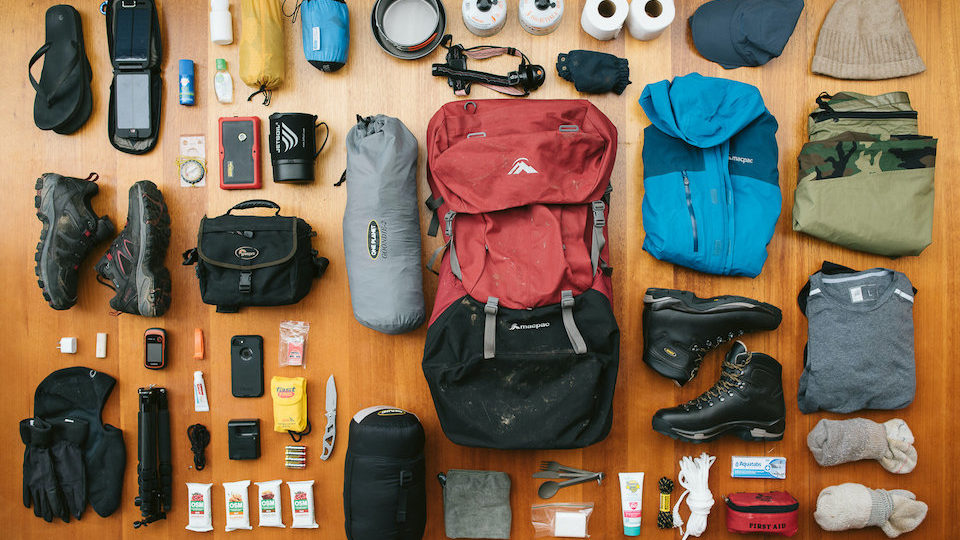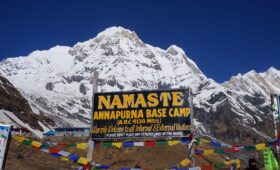For all types of Nepal trekking, trekking equipment is very important. The types of trekking equipment usually depend on the trekking season and the area you choose. However, you always need to carry good trekking gears to avoid undesirable hassles.
A down-jacket or a sleeping bag is not necessary during warm months, but these things are required to tackle freezing temperatures if you trek in the winter. So, good quality and reliable gears are very important to deal with especially tough weather conditions during the trek.
A good Nepal trekking packing list will make your trekking trip comfortable and easy. Often the wrong choice of trekking gear can cause real problems. In these cases, you may have to give up on your trekking trip.
The following Nepal Trekking packing list is highly recommended when packing for your Himalayan trek. This list includes of gears that’ve been recommended by experienced hikers.
The list below is just a guideline. You can adjust according to your need, your interest, season and your region of the trek.
You can find a number of options of all these items in Kathmandu and Pokhara. Most trekking equipment is locally made, so it is cheaper.
What to Pack for Nepal Trekking?
- Down Vest
- Sport Bras
- Thermal Tops/Bottoms
- Lightweight Down Jacket
- A waterproof Jacket
- Fleece Jacket
- Long sleeve shirts
- Gloves
- Underwear
- Shorts
- Trekking Pants
- Waterproof/Windproof Pants
- Fleece Tracksuit Pants
Footwear
- Trekking Boots
- Gaiters
- Socks
- Camp Shoes/ Sandals
Headwear
- Sun Hat
- Wool or fleece hat
- Bandana or Scarf
- Sunglass
Gears
- Sleeping bag
- Duffel bag
- Daypack
- Plastic bags
- Trekking Poles
Personal & Medicals
- Water bottles
- UV Sterilizer or Purification tablets
- Sunscreen & lip balm
- Wet wipes
- Painkiller
- First Aid Kit
- Toiletries
- Hand Sanitizer
- Towel
Accessories
- Head lamp
- Camera
- Binoculars (optional)
Detailed Nepal Trekking Packing List
Clothing: On the trek, the temperature can decrease significantly if you are heading to higher altitudes. So, one best way to keep warm and safe from any temperature change is to use a three-layer system clothing.
Down Vest: On sunny days, it’s extremely helpful to keep your chest warm.
Sports Bras: For female trekkers, sports bras are highly suggested. This well-designed sports bra can keep you locked down tight and wick moisture away from the skin.
Thermal Tops / Bottoms: Thermal tops and bottoms both help you keep your body warm and wick your sweat away. So, you don’t get overheated when the temperature gets high.
Lightweight Down Jacket: Down jacket is the ideal for hiking because it’s very warm and light. And it doesn’t occupy much space in the luggage.
A waterproof Jacket: It gets windy in the evening and sometimes it rains at the high altitude. A waterproof jacket helps you keep dry in the mountains. It will help not sweat if you buy a breathable jacket. And also, the jacket needs to have a hood.
Fleece Jacket: This jacket is light and keeps you warm. If the temperature is cool, you can wear this jacket on the outer layer. It is quite comfortable to carry.
Long Sleeve Shirts: You should go for breathable and light weight polyester shirts. In cold weather, this makes the base layer good. Trekking in warmer weather can also be a good choice.
Long sleeve t-shirts can protect your skin from sunburn and scratches from rocks and plants. The lower altitude is warmer so T-shirts or shirts are suggested.
Gloves: At higher altitudes, cold and cold hands can be dangerous for a long time. So, insulated good gloves are strongly recommended as it keeps your hands warm.
Underwear: Synthetic underwear is more comfortable for long distances while trekking. This will wick moisture away from the skin.
Trekking pants: Lightweight hiking pants help to keep your legs warm during cold days. You should have removable pants, as the afternoon can get hot.
Waterproof / Windproof Pants: If you’re on a rainy or cold weather trek, you’ll have waterproof or windproof trousers to keep you dry. These should not be insulated, they can be used as a shell.
Shorts: It can get warm in the sun while climbing up, especially at the lower altitudes. And it’ll make your pants hot and sweaty. Therefore, shorts give you freedom, and are cooler than pants.
Fleece Tracksuit Pants: These suits are not necessary for trekking, but you can wear them around guesthouses and for sleep.
Footwear
Trekking Boots: You’ll walk on all kinds of trails while on trekking. You will need trekking boots for good traction, which have a lug sole and provide protection for the ankle. In the case of snow or rain they should be waterproof.
You should stop carrying a heavy weight, all leather trekking boots. But your trekking boots have to be broken in first and must fit well. It must be fit comfortably with one thin sock and a mid-weight wool sock.
Gaiters: Trails at the lower altitudes are dry and dusty. Gaiters are perfect for keeping your shoes out of the dust, rain and deep snow.
Socks: You need to go with a lightweight sock for summer. Whereas you need to go with heavyweight socks for the cold weather.
Socks are essential to keep your feet dry and warm, as well as prevent blisters. But you have to remember that you need to coordinate socks and trekking boots for a good fit.
Camp Shoes / Sandals: Camp shoe or sandal are useful in activities when taking a shower etc. You may use it even when hanging around the guest houses. And also, your feet may want to breathe in after a long day of trekking, and sandals are the perfect choice.
Headwear
Sunhat: It is warmer to trek in the summer at lower altitudes. Sunhat protects you from sunburn while hiking on a sunny day and gives you shade.
Wool or fleece hat: You’ll definitely need these at higher altitudes as it’s colder and windier. Your head warms up.
Bandana or scarf: Many hiking trails are dusty, especially at the lower altitudes. You can tie a scarf round your nose and mouth in this case.
Sunglasses: Exposing yourself to high-intensity UV rays in the high-altitude trails can be risky to your eyes. This can cause dizziness and headache. Snow and glacier intensify the UV rays even more. Therefore, you need to use UV protection sunglasses to prevent snow blindness.
Gears
Sleeping bag: You should stay warm during cold nights. The sleeping bag must withstand a minimum temperature of -10 ° C and should be made from duck or goose down.
For extra warmth it should have insulated hood.
Day-pack: This is your day pack where you carry your personal belongings every day. This needs to be comfortable and large enough to hold bottles of water, camera and extra clothes (a t-shirt). It must come with a rain cover, so that both rain and snow will keep your gears dry.
Duffel bag: The duffel bag should be waterproof, strong and lockable.
Plastic bags: It is useful to store and organize your dirty laundry.
Trekking Poles: Trekking poles will ensure a good balance for you and protect your knees. If you go downhill on your trek you will find these useful.
Personal and Medicals
Water bottles: 2 water bottles are recommended each 1-liter. You should take metal water bottles because then you can fill hot water at night, and take it to bed. It’ll help you to keep warm on a cold night.
Water purification tablets: You will get the mineral water at a cheap price at the start of the trek. But when you go up higher, then the water bottle can break your trek budget. So, you have to take water purification tablets or water filters to sterilize your water before drinking.
Sunblock and Lip-balm: UV rays are very harmful at higher altitudes, so you need extra protection. You need to use sunblock to protect from the sun. You need to bring sunblock and lip balm with SPF 40+ is recommended.
Wet wipes: Hot showers are limited in the higher altitudes, so it is very hard to take a regular cold-water shower. In such case, wet wipes can also be used to clean your hand, face, and feet as well.
Painkiller: Almost all trekkers sometimes suffer from an occasional headache due to change in the environment. Painkiller will help you reduce the pain.
First Aid Kit: You should carry along any personal prescribed medications.
Toiletries: Basic toiletries like toothbrush, toothpaste and toilet papers need to bring.
Hand Sanitizer: Hand sanitizer is also very useful for a quick wash before eating. This stuff keeps you hygienic during the hiking.
Towel: Some of the guesthouses don’t provide towels. So, it’s better to bring light and small towels for trekking.
Accessories
Head lamp: A headlamp is necessary. You will need it to light your way in the night / early in the morning.
Camera: You’ll need a camera to catch your beautiful moments during trekking. You also need to bring a memory card and extra batteries.
Binoculars: Binoculars are useful for trekking, because it helps you to take a closer look at the stunning mountain ranges.
Final Say
Trekking in the Himalayas is rewarding, yet challenging too. Wearing the right trekking gears will make your stay comfortable and you can focus fully on your Nepal trekking journey.
Considering all of the above equipment, you can make a Nepal trekking packing list for your adventure accordingly.
Please Note: This is just a general guideline and taking all the things mentioned above is not mandatory. Although it is better to be prepared well as the weather in the mountain region is unpredictable. Please keep in mind, you should also try to minimize the weight of your equipment.
If you have any questions regarding Nepal trekking packing list, feel free to contact us.
Do you have any question about trip to Nepal?
Tell us about your trip to Nepal and what you expect from it. We will answer your questions in 24 hours and help you design a trip with a comfortable itinerary to best meet your needs.





